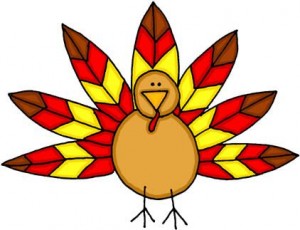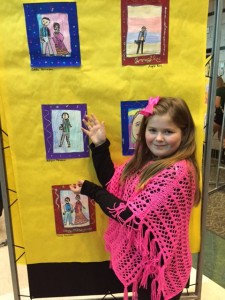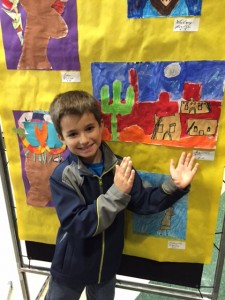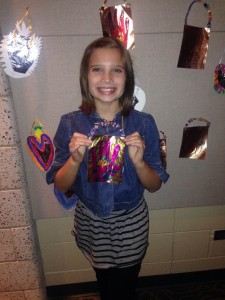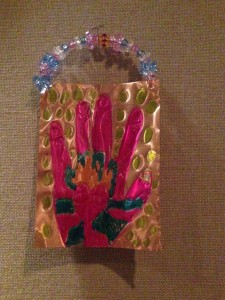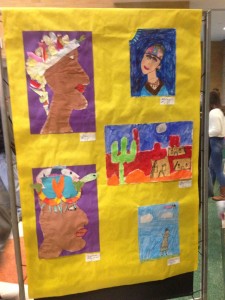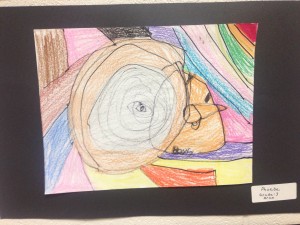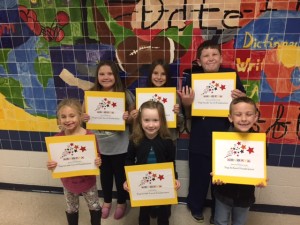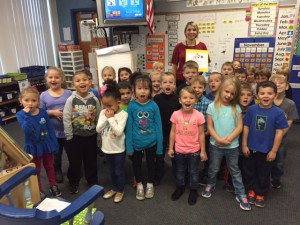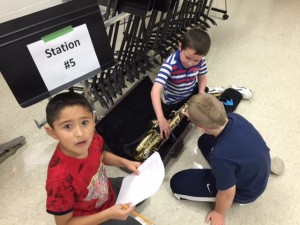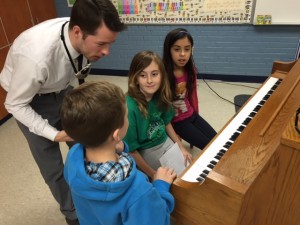Coming soon at Arno….
November 9
504 Meetings
Ad Council 9:00
Spirit Wear Fall Sale
November 10
Yearbook Candid photos
Rotary Club reading with 1st grade
November 11
REED per schedule
4th grade to Parade Company 9:45
Sp ed/Rdg spec/Title 1 team meeting 2:50
PBIS meeting 3:45
PTA council meeting 7:00
November 12
Picture retake day
Limo and Lunch for fun run winners 11:30
November 13
End of 1st Q
Title 1 parent advisory meeting 8:40
PTA Mother/Son night 6:00
Mark it on you calendar
We will be having a couple of events coming up here for conferences and the holidays. Please mark it on your calendar and come hungry!
November 19 At 4:00- Pizza and breadsticks will be served in the lounge to get you ready for the big night ahead
December 10 from 11:00 (K-3) 11:10 (4-5) for an hour staff holiday lunch in the Arno Ballroom (AKA the gym). We have arranged a special lunch schedule that day so that you may all eat together.
Huge Thank You (s)
A very special thank you for being awesome to Sarah and Todd. To Sarah for a great job helping our building move forward with signupgenius and to todd for a great job presenting Planbook at our PD Tuesday- It’s great to showcase Arno’s talent off to the district. As of now, all 3 buildings are moving forward with signupgenius! Thanks so much!!
Spirit Wear Kickoff Monday
In addition to our book fair Christmas gifts you can gather, the PTA spirit wear kickoff starts this Monday. Shopping is easy- it’s all online and delivered straight to your house- that’s right- it comes to your home. Please follow the link below and enjoy shopping for Arno Spirit Wear! Enjoy free shipping from Nov. 9-18 using code: AR1115
http://arnospiritwear.com/shop
MTSS (Multi-tiered system of support)
A new committee has been formed at the district level to build systems of support and intervention at our buildings. Jennifer, Lisa, and I will be attending the first meeting this month, followed by a school visit to Livonia to see this in action in an elementary building. I will keep you posted with news as we move forward.
http://www.michigan.gov/mde/0,4615,7-140-28753_65803-322534–,00.html
Data Team
Our current list of brave volunteers for the Arno data team are Tracy, Brian, and Sharon. Please let me know if you’re interested. We will initially meet on Nov 30 from 3:45-4:30
Fall Art and Music Show
Arno pride was beaming forward at the Fall Art and Music show last Thursday at the Performing Arts Center. Art from the elementary and high school levels was showcased and I was so very proud of the talent we have at our school! Our young artists and some pics are below:
Christian Bass, Elizabeth Figurski, Drake Steele, Isabella Garrison, Christian Hernandez, Riley McNamara, Anna Watson, Elizabeth Antrassian, Meadow Mechanco, Natalya Porras, Sean Feebish, Whitney Hertzog, Megan Mary-Helene Holly, Dawn Hudson, Paytin Pearson, Emma Stallions, Kaylah Stanfield, Gabrielle Stanley, Avery Barrow, Carlos Sanchez, Elizabeth White, Isabelle Castro, Emma Edwards, Samantha Holt, Emily Konkel, Jayden Lopez, Jeran Moody, Brayden Pasko, Liam Shepherd, Cierra Tasker, Luna Fitzgerald, Mallory Hool, Ben Klos, Clara Ziegler, Cherish Wilson, Sophia Kaloian, Ava Rekus, Alaynna Lazarowicz, Jillian Kropog, Susie Oh, Marshall Hegedus, Porsche Tasker, Gwen Mccue, Isabella Harrison, Dominic North, Colton Gencyuz, Grace Grabowski, Angelo Baez, Jorja Siddall, Rocco Crapanzano, Aaliyah Mendoza, Leslie Hernandez, Julia Schroeder, Reina Garza, Aidan Kubitz, Kaiden Cook, Anahi Chapa, Peyton Will, Isabelle Maldonado, Mary Dunne, Jordan Tasker-King, Steven Stewert, Chris Plascencia, Luci Granata, Addison Bacheller, Juliette Torres, Teagan Montgomery
Fun Run winners
Congrats to all of our Fun Run top sellers! We will be having our lunch and principals day this month.
The top fundraisers by grade are:
Kindergarten: Alyssa Bommarito
1st: Jenna King
2nd: Antonio Kulaszewski
3rd: Savannah Hardy
4th: Vincenzo Kulaszewski
5th: Elizabeth Figurski
Antonio and Vincenzo Kulaszewski will each spend a day as Principal
All top earners will also be treated to a lunch and limo ride with Mr. Zielinski. Mrs. Liedel’s class was the top class and earned a pizza lunch.
Music is in the air…
4 Tips for Guided Reading Success
Power strategies to launch your guided reading groups.
- Grades: PreK–K, 1–2, 3–5, 6–8

Prompting for SuccessAuthor and former teacher Jan Richardson offers a host of free guided-reading resources on her website (www.janrichardsonguidedreading.com), including these prompts for “during reading” instruction.
Monitoring
- Are you right?
- Does that make sense?
- Does it look right? Check it with your finger.
Decoding
- Say the first part and check the picture. What would look right and make sense?
- Can you break it into parts?
- Do you know another word that looks like this one?
Fluency
- Try reading it without pointing.
- How would the character say that?
- Put some words together so it sounds smooth.
Vocabulary
- Is there a word you don’t understand?
- Are there clues in the sentence or illustration to help you?
- Is there a part in that word that can help?
Comprehension
- What’s happening on this page?
- Is there a confusing part? What don’t you understand?
- Why do you think the character did (or said) that?
Many teachers have guided reading in their instructional toolbox, and they consider it a necessary strategy, especially in classrooms where differentiation is key. For Allison Hepfer, who teaches kindergarten at Hamagrael Elementary in Delmar, New York, guided reading is a cornerstone of her literacy instruction. She meets with small groups of students on a daily basis, supporting them as they learn to use reading strategies.
“Guiding reading is one of the best ways to differentiate,” Hepfer says. “By grouping children by reading levels, I can target specific skills and strategies needed to advance to the next level. Children at the initial stage may need instruction about left-to-right progression, while those at a higher level can learn to use picture cues to decode new words. Small-group work with guided reading is critical to meet the needs of all learners.”
According to Hepfer and other experts, the beginning of the year is a crucial time to set the tone for guided reading groups. From rules and routines to activities and assessments, we’ve compiled a guide to guided reading to help you get your groups up and running.
Establish Routines to Foster Independence
Establishing routines at the beginning of the year is crucial. “Before you ever meet with a small group, make sure the rest of the class understands the routines and activities they’re doing while you’re working with the group,” says Jan Richardson, author of The Next Step in Guided Reading and a former classroom teacher, reading specialist, and Reading Recovery teacher. “You get in trouble if you try to start the year without having taught children how to be independent.”
Even the youngest students can become independent through explicit instruction and practice. In the first weeks of school, you might teach a mini-lesson about how to choose a “just right” book for independent reading, or one on when to interrupt a guided reading group (only in a true emergency) and when not to interrupt (basically for any other reason).
“We spend the first three or four weeks of school just doing management and rules and routines,” says Kelly Anderson, a third-grade teacher at East Side Elementary School in Marietta, Georgia, who uses guided reading with the struggling readers in her class. “We teach student responsibilities and teacher responsibilities. The students should understand that as a teacher you also have a job to do.”
What type of work should students do independently while you’re meeting with a group? That may depend on your school’s literacy block model, but here are a few ideas.
- “Do something purposeful. I outlaw worksheets,” says Richardson. “Do independent reading or any letter-sound work, spelling, or vocabulary practice. Allow students to write extensions to stories they started in writers’ workshop.”
- Hepfer’s students use the time to read a book at their independent level or to read with a partner. “I model partner reading a lot and create anchor charts with visual models. I even videotape partnerships, and we watch them on the SMART Board. I show students what reading partners look like and sound like.”
- “Listening centers are easy to manage and great for your younger learners or for your English language learners,” says Richardson, “For the intermediate children, they should be reading, preparing for their book clubs, or doing research.”
Practice these routines and activities every day. Build students’ stamina until they can function on their own for the 15 to 20 minutes you’ll need to meet with a small group.
Make Smart Text Choices
When you’re ready to kick off your small-group guided reading lessons, begin by placing students in groups based on their reading levels and instructional needs. “I like to group children according to a reading range around a focus strategy. It could be monitoring, decoding, fluency, or comprehension,” says Richardson.
Next, choose the right book—and choose wisely. “Guided reading can flop or fly based upon the text choice. If it’s too easy, there’s nothing for the child to learn,” Richardson says. “But if it’s too difficult, the teacher has to do the reading for the student. That doesn’t increase the child’s problem-solving skills.”
If you’re staring at a shelf full of Level D texts, which book should you choose? Interest level and conceptual knowledge are considerations. “For primary readers, be sure the story makes sense. Sometimes early-level texts are so focused on developing sight-word knowledge that the story gets lost, ” says Debbie Rosenow, a literacy coach for Hamilton County Schools in Tennessee. “For the intermediate grades, try to identify shorter texts such as short stories, nonfiction articles, and poems that students can finish in one or two days.
“The text should provide multiple opportunities for students to apply strategies and skills [you have identified for the group],” advises Rosenow.
Dive Into Instruction
Divide your lesson into segments: before, during, and after reading.
- Before Reading: “I’ve seen teachers spend 15 minutes talking about the book, and the children have only two minutes to read it,” says Richardson. She suggests a one-sentence “gist” statement and a quick preview. For second-language learners, you might need to spend more time, “but for other children, look into the book and then let them start reading.”
- During Reading: Allow students to read independently—either by reading silently or by whisper reading. Students should not read round-robin, as they used to do. Instead, make your way around the group to work one-on-one with each student for a few minutes. If they are reading silently, ask them to whisper read to you when it’s their turn. Different students will need different strategies—some may need support using first-letter cues, while others may need help monitoring their comprehension (see sidebar). “The idea of guided reading is scaffolding children while they read, doing it with the teacher’s support,” Richardson says.
- After Reading: First, you should check for students’ comprehension, which can be done in the form of a discussion question, such as “How did this character change from beginning to end?” You can also use the time for a predetermined word study (e.g., on digraphs) geared toward the group’s needs.
Writing about the text is a good practice as well, and it allows you to collect a writing sample. “The children might do a dictated sentence at an early level. As they move up, they get more responsibilities for coming up with the message,” says Richardson. For older students, Rosenow says these post-reading writing activities could include creating five or six imitation Facebook posts or tweets from a character’s point of view.
Assess, and Be Flexible
Remember: The composition of your guided reading groups isn’t etched in stone. Your groups should be fluid and should change as your students’ instructional needs change. That’s where informal and formal assessments come in handy.
Of the informal assessments, running records are extremely useful for determining whether students should be moved to another group.
“I complete informal running records on a -biweekly basis,” explains Hepfer. “Because the children in kindergarten change at such different paces, the groups must be flexible. I also look to see if there are children who need help with similar skills and group them accordingly.”
Formal assessments, such as the Developmental Reading Assessment or the Fountas and Pinnell Benchmark Assessment System, given at the beginning, middle, and end of the school year, will also help with tracking students’ progress. By year’s end, you’ll see just how much they’ve grown as readers.
“At the beginning of last year, I had a student who entered kindergarten identifying only a few letters and sounds,” says Hepfer. “He did not see himself as a reader. At first we focused on things such as concepts of print, letter sounds and names, and using pictures to help figure out a tricky word. As each month passed, he gained confidence. [At the end of the year], he looked up at me and exclaimed, ‘You were right, Mrs. Hepfer. I am a reader!’ ”
Have a Great Week!

